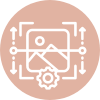Services
MIDA.science offers comprehensive assistance in the design and execution of microscopy experiments and image and data analysis, and helps you find the optimal balance between them to fully unleash the potential of your quantitative microscopy experiments. Read about MIDA.science Microscopy, Image Analysis, and Data Analysis services, and How to contract a service.

Microscopy
MIDA.science assists you in planning and optimising microscopy experiments, developing dedicated software, or executing the imaging itself.
Read more
Image Analysis
MIDA.science assists you in choosing, adapting, or developing image analysis solutions for your scientific goals and helps the optimisation of your microscopy experiments to maximise the quality of the image analysis results.
Read more
Data Analysis
MIDA.science assists you in performing data and statistical analysis and choosing the best solutions to interpret and communicate your measurements effectively.
Read more
Consulting
MIDA.science consulting services will help you find the right balance between Microscopy, Image Analysis, and Data Analysis to perfect and enhance your microscopy.
Read moreHow to contract a service
You can choose between two formats of collaboration: service based, or contractual.
Service-based consulting is ideal for addressing a specific topic. It results in an invoice based on the number of hours required to achieve the desired goal, which can be agreed upon in advance.
Pros: This form of collaboration may be the easiest to fund through research grants.
Cons: It offers little adaptability.
Contractual consulting involves an agreement for a set number of hours to be distributed over a period of time according to specific needs. For example, one hundred hours could be allocated over a year across activities such as advice and planning, assistance with imaging, coding, or statistics. This arrangement is ideal for ambitious research projects requiring flexibility to adapt to evolving needs, which may be difficult to predict.
Pros: It offers maximum flexibility and can be more cost-effective than service-based invoices. It can also be conveniently arranged at the end of a financial year to make use of unspent funds.
Cons: It may be more complicated to pay for, depending on the various grant rules.